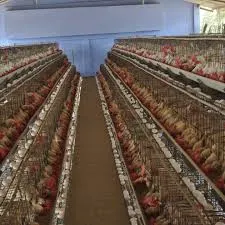Optimal Design for Chicken Layer Cage Systems in Modern Poultry Farming
Nov . 07, 2024 13:59 Back to list
Optimal Design for Chicken Layer Cage Systems in Modern Poultry Farming
The Chicken Layer Cage An Overview of Benefits and Considerations
In the modern agricultural landscape, poultry farming has evolved significantly to meet the growing global demand for eggs. One of the most effective systems employed in this sector is the chicken layer cage system. This method provides a controlled environment for hens that optimizes productivity and ensures hygiene, making it a popular choice among poultry farmers worldwide.
The fundamental principle of a chicken layer cage system is to house hens in a confined space that allows for efficient egg production. These cages are designed to accommodate multiple hens while maximizing space utilization, which is crucial in commercial operations. The advantages of this system include increased egg production rates, better food conversion ratios, and simplified management of the birds.
Benefits of Chicken Layer Cages
1. Maximized Egg Production One of the primary benefits of using chicken layer cages is the ability to boost egg production. Hens in cages tend to lay more eggs compared to those raised in free-range systems. The confinement reduces stress and competition for resources, such as food and nesting space, which can lead to higher productivity.
2. Ease of Management Managing a large flock of hens can be challenging, but layer cages simplify this process. With the birds housed in a confined space, farmers can easily monitor their health and well-being. Automated systems can be integrated to provide feed, water, and ventilation, thus reducing labor costs and improving efficiency.
3. Disease Control The cage system enhances biosecurity measures by minimizing the risk of disease transmission. Because the birds are separated from one another, it is easier to control the spread of pathogens. Additionally, the enclosed environment simplifies sanitation efforts, helping to maintain a clean and healthy living space for the hens.
chicken layer cage

4. Environmental Control Layer cages allow farmers to regulate the living conditions of the hens more effectively. Temperature, humidity, and light can all be adjusted to create an optimal environment for egg production. This control not only promotes the health of the hens but also enhances overall productivity.
Despite these advantages, the chicken layer cage system is also subject to criticism, primarily concerning animal welfare. Critics argue that confining hens in cages restricts their natural behaviors, such as nesting, roaming, and dust-bathing. This has led to increasing demand for cage-free egg production methods. In response, many farmers are exploring alternative housing systems that balance productivity with animal welfare, such as barn systems or free-range options.
Regulatory Changes and Sustainability
In recent years, regulatory changes in several countries have imposed stricter requirements on poultry housing, including limits on cage sizes and mandates for enrichment features. This shift reflects a growing societal concern for humane treatment of animals in agricultural settings.
As the poultry industry continues to evolve, there is an increasing push towards sustainable farming practices. This includes improving the welfare of hens while still maintaining high levels of productivity. Many farms are now transitioning to enriched cage systems, where hens have more space, access to nesting areas, and the opportunity to engage in natural behaviors, striking a balance between efficiency and welfare.
In conclusion, the chicken layer cage system plays a significant role in modern poultry farming by enhancing productivity, simplifying management, and promoting biosecurity. However, the industry must navigate the challenges of animal welfare and regulatory changes. The future of poultry farming may lie in innovative solutions that prioritize both the needs of farmers and the well-being of hens, ensuring a sustainable and ethical approach to egg production.
-
Hot Sale 24 & 18 Door Rabbit Cages - Premium Breeding Solutions
NewsJul.25,2025
-
Automatic Feeding Line System Pan Feeder Nipple Drinker - Anping County Yize Metal Products Co., Ltd.
NewsJul.21,2025
-
Automatic Feeding Line System Pan Feeder Nipple Drinker - Anping County Yize Metal Products Co., Ltd.
NewsJul.21,2025
-
Automatic Feeding Line System - Anping Yize | Precision & Nipple
NewsJul.21,2025
-
Automatic Feeding Line System - Anping Yize | Precision & Nipple
NewsJul.21,2025
-
Automatic Feeding Line System-Anping County Yize Metal Products Co., Ltd.|Efficient Feed Distribution&Customized Animal Farming Solutions
NewsJul.21,2025






